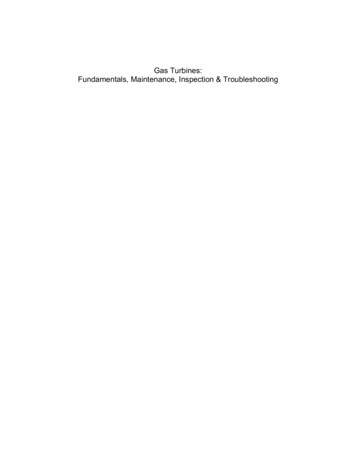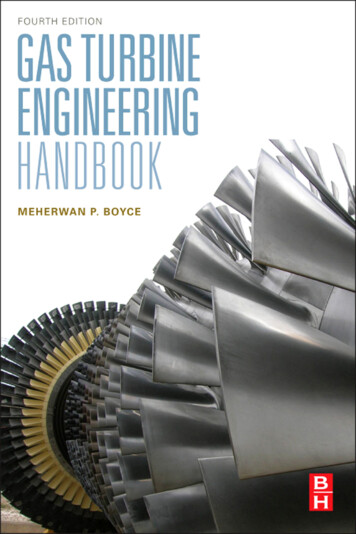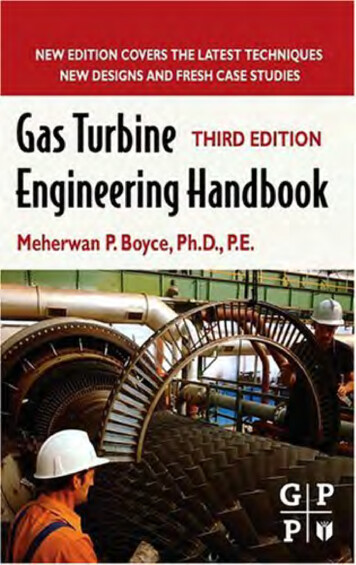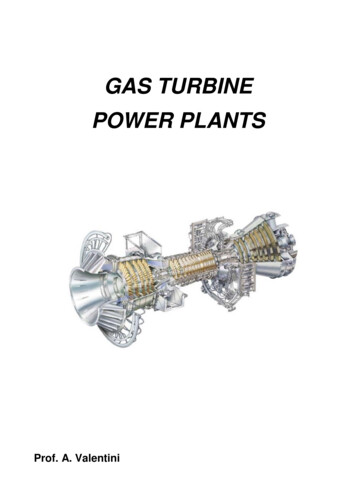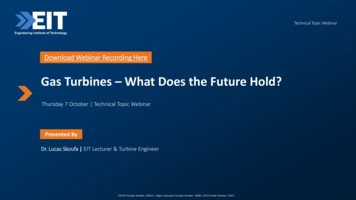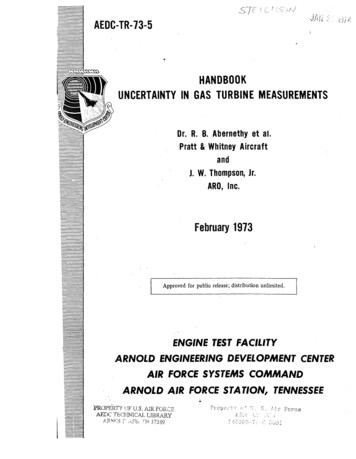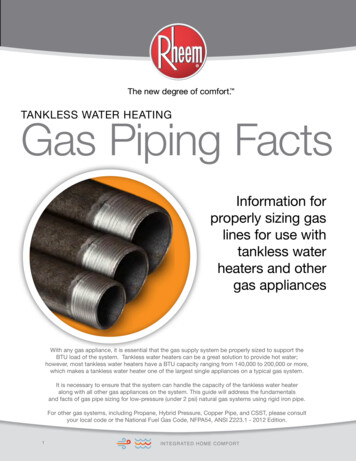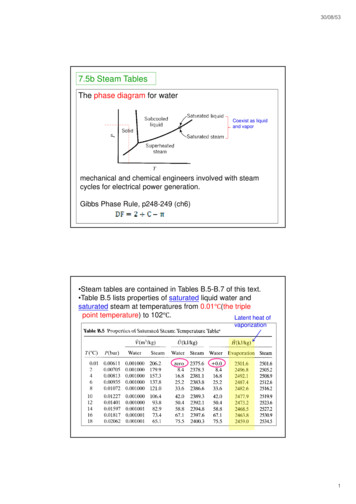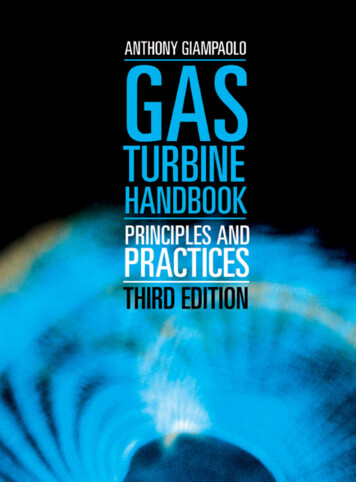
Transcription
Gas Turbine Handbook:Principles and Practices3rd Editioni
This page intentionally left blank
Gas Turbine Handbook:Principles and Practices3rd EditionbyTony Giampaolo, MSME, PEiii
Library of Congress Cataloging-in-Publication DataGiampaolo, Tony, 1939Gas turbine handbook: principles and practices/by TonyGiampaolo.--3rd ed.p. cm.Includes bibliographical references and index.ISBN 0-88173-515-9 (print) -- ISBN 0-88173-516-7 (electronic)1. Gas-turbines--Handbooks, manuals, etc. I. Title.TJ778.G48 2006621.43'3--dc222005055216Gas turbine handbook: principles and practices by Tony Giampaolo--Third Edition 2006 by The Fairmont Press. All rights reserved. No part of this publication maybe reproduced or transmitted in any form or by any means, electronic or mechanical, including photocopy, recording, or any information storage and retrieval system, without permission in writing from the publisher.Published by The Fairmont Press, Inc.700 Indian TrailLilburn, GA 30047tel: 770-925-9388; fax: d by Taylor & Francis Ltd.6000 Broken Sound Parkway NW, Suite 300Boca Raton, FL 33487, USAE-mail: orders@crcpress.comDistributed by Taylor & Francis Ltd.23-25 Blades CourtDeodar RoadLondon SW15 2NU, UKE-mail: uk.tandf@thomsonpublishingservices.co.ukPrinted in the United States of America10 9 8 7 6 5 4 3 2 10-88173-515-9 (The Fairmont Press, Inc.)0-8493-9056-7 (Taylor & Francis Ltd.)While every effort is made to provide dependable information, the publisher, authors, andeditors cannot be held responsible for any errors or omissions.iv
DedicationThis book is dedicated to my wife Gay. We havebeen married over 44 years and have known eachother for close to 50 years. She has accompaniedme from coast to coast of the USA and to SaudiArabia, to make a home for our children and me.I can honestly say she regarded these moves asadventures, and anticipated each one with excitement and enthusiasm.I thank her for her support, her companionship, and her love—she is my soulmate.v
This page intentionally left blank
ContentsPREFACE . xiACKNOWLEDGMENTS .xiiiChapter 1—THE GAS TURBINE EVOLUTION . 1History . 1Technical Improvements . 7Chapter 2—APPLICATIONS .11Jet Engines .11Mechanical Drive. 15Chapter 3—HARDWARE . 23Similarities and Differences . 23Compressors . 27Turbines . 27Combustors . 35Bearing Design . 39Chapter 4—GAS TURBINE SYSTEMS THEORY. 45Gas Turbine Operating Cycle . 45Component Efficiencies . 49Compressor . 52Burner Section . 64Turbine . 66Chapter 5—GAS TURBINE CONTROLS . 71Gas Turbine Controls . 71Chapter 6—ACCESSORIES (Lube Oil, Coolers, Power) . 85Starting Systems . 85Ignition Systems . 90Lubrication Systems . 94Characteristics of Lube Oils . 100Chapter 7—PARAMETER CHARACTERISTICS . 105Vibration . 105vii
Vibration Measurement . 107Exhaust Gas Temperature (EGT) . 109Rotor Speed . 109Oil Pressure & Temperature.111Chapter 8—GAS TURBINE INLET TREATMENT.115The Environment .115Inlet Air Filters.117Filter and Gas Turbine Match . 122Inlet Air Cooling . 122Chillers. 130Chapter 9—GAS TURBINE EXHAUST TREATMENT . 131Water Injection . 137Steam Injection. 138Selective Catalytic Reduction . 139Chapter 10—GAS TURBINE ACOUSTICSAND NOISE CONTROL . 145Combustion Turbines—Lots of Power in a Little Space. 145Some Fundamentals of Acoustic . 148Noise Criterion . 154Noise Control . 155Chapter 11—MICROTURBINES . 169Microturbines . 169Applications . 170Hardware . 172Chapter 12—DETECTABLE PROBLEMS . 183Gas Path Analysis . 184Turbine Blade Distress . 187Compressor Fouling . 195Combustor Distress & Plugged Fuel Nozzles . 199Foreign/Domestic Object Damage . 199Worn Air/Oil Seals . 201Fuel Control Problems . 202viii
Chapter 13—BOROSCOPE INSPECTION . 205Objectives & Expectations . 205A Back-up to Confirming Suspected Problems . 208Assessing Damage to the Compressor,Combustor, and Turbine. 209Chapter 14—CASE HISTORY 1 . 229Chapter 15—CASE HISTORY 2 . 249Chapter 16—CASE HISTORY 3 . 261Chapter 17—CASE HISTORY 4 . 269Chapter 18—THE GAS TURBINE’S FUTURE . 279Appendix A1. Gas Turbine Manufacturers(Names, Addresses, Phone Numbers) . 2872. Microturbines Manufacturers . 304Appendix B1. Accessory Manufacturers(Names, Addresses, Phone Numbers) . 305Appendix C1. Stanford Research Institute Chart . 3262. PWA Material Chart. 3283. Formulas (Interrelationship of Engine Parameters). 3464. Hazardous Area Classification . 3545. Air Filter Selection Guideline Checklist . 3556. Air/Oil Cooler Selection Guideline Checklist . 3587. Gaseous Fuel Properties . 3638. Liquid Fuel Properties . 3709. List of Symbols . 37210. Conversion Factors . 37511. Inlet Water Cooling (Fogging) . 38012. Overall A-weighted Sound Level Calculation . 383ix
13. Occupational Noise Exposure . 38514. Elden F. Ray, Jr., P.E. Resume .38715. Microturbine and Power Converter Manufacturers . 389Appendix D1. Technical Societies . 3912. Technical Articles . 396Index . 427x
Preface to the Third EditionThe need for the 2nd Edition was based on the realization thatthe book lacked sufficient guidelines in projects that I was involved with;specifically, wet compression and acoustics. In 2002 I updated this bookwith the 2nd Edition.This 3rd Edition is undertaken to cover a subject that captured mytime and attention and is of interest to many people not usually involvedwith gas turbines. This subject is microturbines. Microturbines were firstconsidered a viable product in the early-to-mid 1990’s. Part of the popularity with the idea of a very small gas turbine was the result of the successes with miniaturization in the electronic industry; part was the lack ofcompetition for reciprocating engines; and part was the steadily increasing price & decreasing availability of electricity. Price and availability ofelectricity led to the concept now known as Distributed Generation (DG).And the microturbine fits DG to a tee.Looking back into 19th Century history, machines strikingly similar to today’s microturbine were being developed. True they were large,bulky machines, but they had the same characteristics. For example, theyhad centrifugal compressors & turbines, single combustors and, in somecases, a heat exchanger that captured exhaust gases to heat the compressordischarge air before it entered the combustor (a recuperator or regenerator). Each was a stand-alone component coupled together by shafts, hubs,and ducting. But thermodynamically these machines are identical.Prior to the introduction of microturbines the only drivers available in the 600 and under horsepower range were reciprocating engines.These reciprocating engines are large, they vibrate, they are noisy, theyare fuel specific, and they require frequent maintenance. By comparisonthe microturbine is small, quiet, relatively vibration and maintenance free,and tolerant of a wide range of fuels.The microturbine innovators had the vision to see the potentialin a very small gas turbine. A vision similar to Frank Whittle’s and HansPabst von Ohain’s vision of utilizing a gas turbine for jet power. Theywere able to look at engine turbocharger components and visualize howthe addition of a combustor could turn them into a gas turbine. Further,they could visualize how a recuperator, wrapped around the combustorcould enhance performance, reduce emissions, and minimize the packagexi
footprint. To produce sufficient power to make these units saleable theyhad to operate at high temperatures and very high speeds.Advances in bearing designs and air bearings, high temperaturemetallurgy, and fast computer controls had their roots in the aviationindustry. Like the turbocharger components, these advances were alreadyavailable. And so a new application of an old technology was born.Chapter 11 – Microturbines should be a benefit to plantmanagers, engineers, and operators who are either considering installingmicroturbines or who already have microturbines installed and are lookingfor help operating & maintaining them.Beside the new chapter on microturbines, Chapter 10 - Acousticshas also been updated with the assistance of Mr. Eldon Ray, P.E. While thechanges from the 2nd Edition may be subtle, I believe this rewrite makesthis chapter easier to read and acoustics easier to understand.In addition Chapter 17 - Case History #4 has been added tohighlight the application of the microturbine; Chapter 18 – The GasTurbine Future has been rewritten to identify recent trends in gas turbineprogress and reemphasize the advances toward hydrogen fuels.Finally Appendix A-1 has been updated with Diesel and GasTurbine Worldwide 2005 Gas Turbine Manufacturers (Names, Addresses,Phone Numbers) and the addition of Appendix A-2 Microturbine Manufacturers. Also additional information has been added to Appendix D- Technical Societies and D-2 Technical Articles as they relate to microturbines.I hope this book will continue to be a useful tool for the reader foryears to come.Tony GiampaoloWellington, FloridaAugust 8, 2005xii
AcknowledgmentsI wish to thank the following people for their assistance in proofreading this book and for their suggestions and ideas: Robin Kellogg,Editor of Western Energy Magazine; Carl Gipson, Jr., MSME, mysister Loretta Giampaolo, BAN, RN; and my son Vince Giampaolo,MSM&PO, MANS&SS, Lt. Comdr., USN. I must also thank PaulCrossman for his support in arranging the first Gas Turbine Seminar,upon which this book is based.I am also grateful for the support I have received from my family:my wife, my children and their spouses.I would like to acknowledge the contribution of Mr. Eldon F. Ray,Jr., P.E., for providing the chapter on acoustics (Chapter 10).Finally I would like to thank the following companies for theirconfidence and support by providing many of the photographs andcharts that are in this book:ABB STAL ABAmerican Air Filter InternationalASEA Brown Boveri AGBaltimore Aircoil CompanyCapstone Turbine Corp.Catalytica Combustion SystemsCooper Cameron CorporationDEMAG DELAVAL Turbomachinery Corp.Diesel & Gas Turbine Worldwide CatalogElliott Energy System, Inc.Farr Filter CompanyGeneral Electric CompanyHarbor Cogeneration CompanyIngersoll-Rand Energy SystemsOlympus America Inc.Rolls Royce Industrial & Marine Gas Turbines LimitedSolar Turbines IncorporatedSRI InternationalUnited Technologies Corporation Hamilton Standard DivisionUnited Technologies Corporation Pratt & Whitney AircraftUnited Technologies Corporation Pratt & Whitney Canadaxiii
Evolution of the Gas Turbine1Chapter 1Evolution of the Gas TurbineThrough the design experience developed for steam turbinesand available to gas turbines, it is not surprising that gasgenerator compressors, turbines, and power-extractionturbines bear a striking resemblance to each other and to the steamturbine. Nor should it be surprising that the axial flow compressorsof today’s gas turbines resemble the reaction steam turbine withthe flow direction reversed. While many people today recognize thesimilarities between steam and gas turbine components, most do notfully appreciate the common history these two products share. History tells us that the idea for the gas turbine and the steam turbinewere conceived simultaneously. As early as 1791, John Barber’s patent for the steam turbine described other fluids or gases as potentialenergy sources. “John Barber invented what may be considered agas turbine in which gas was produced from heated coal, mixed withair, compressed and then burnt. This produced a high speed jet thatimpinged on radial blades on a turbine wheel rim.”1 John Barber’sideas, as well as those before him (Giovanni Branca’s impulse steamturbine—1629, Leonardo da Vinci’s “smoke mill”—1550, and Hero ofAlexandria’s reaction steam turbine—130 BC)2 were just ideas. Eventhough the gas turbines described by these early visionaries wouldtoday be more accurately termed ‘turboexpanders’ (the source of compressed air or gas being a by-product of a separate process), there isno evidence that any of these ideas were ever turned into workinghardware until the late 19th Century.For the next 90 years ideas abounded, but all attempts to produce working hardware were unsuccessful. As Norman Davy stated in1914, “The theory of the gas turbine was as fully grasped by Barberat the end of the eighteenth century, and by Bresson in the beginningof the nineteenth century, as it is by experts today. The success of thegas turbine as a heat engine rest solely upon practical limitations.”31
2Gas Turbine Handbook: Principles and PracticesHowever, even in this period of unsuccessful attempts at producing aworking prototype, progress was still being made. In 1808 John Dumball envisioned a multi-stage turbine. Unfortunately his idea consisted only of moving blades without stationary airfoils to turn the flow into each succeeding stage.1,3,4Had he realized the need for a stationary stage between eachrotating stage he would have originated the concept of an axialflow turbine. In Paris in 1837, Bresson’s idea was to use a fan to drive pressurized air into a combustion chamber. Here, the air was mixedwith fuel gas and burnt. These combustion products were cooledby the addition of more air, and this final product was used todrive turbine blades.1,2 In 1850, in England, Fernimough suggested a mixed steam andgas turbine, in which air was blown through a coal grate whilewater was sprayed into the hot gases. The gas and steam mixture then acted to drive a two-bladed rotor.1 Not until 1872 did Dr. Franz Stolze combine the ideas of Barberand Dumball to develop the first axial compressor driven by anaxial turbine.1 Due to a lack of funds, he did not build his machine until 1900. Dr. Stolze’s design consisted of a multi-stageaxial flow compressor, a single combustion chamber, a multistage axial turbine, and a regenerator utilizing exhaust gases toheat the compressor discharge air. This unit was tested between1900 and 1904, but never ran successfully.As will be discussed in Chapter IX, Bresson’s ideas are the basisof air cooling (to extend hot gas path part life), Fernimough’s ideasare the basis for water injection (for power augmentation and laterNOx control), and Stolze’s ideas led the way for application of boththe present day trends in gas turbine design and the regenerator forimproved efficiency.It was not until 1884 with Sir Charles Parsons’ patent for a reaction steam turbine and gas turbine, and 1888, with Charles de Laval’sapplication of Giovanni Branca’s idea for an impulse steam turbine
Evolution of the Gas Turbine3(Figure 1-1) did workable hardware emerge.1,3 In the 1895/1896 timeframe variations in the impulse turbine designs were developed byAugust C. Rateau, Charles Curtis, and Dr. Zoelly. The experiencegained in the development of hardware for steam turbines was directly transferable to gas turbines. At the end of the 19th Centurythe ideas of the previous centuries were finally being transformedinto working hardware.In 1903, Rene Armengaud and Charles Lemale built and successfully tested a gas turbine using a Rateau rotary compressor anda Curtis velocity compounded steam turbine. Armengaud and Lemalewent on to build and test several experimental gas turbines. Originally they used a 25 HP de Laval steam turbine driven by compressedFigure 1-1. Courtesy of DEMAG DELAVAL Turbomachinery Corp.This graphic, the first trademark of De Laval Steam Turbine Company, illustrates the impulse-type turbine wheel with expandingnozzles. This single-wheel, high-speed, impulse turbine operated atthe then incredible speed of 30,000 rpm.
4Gas Turbine Handbook: Principles and Practicesgases from a combustion chamber, which was fed from a compressor.The turbine and compressor ran at 4,000 rpm and, in another earlyexample of steam injection, temperatures were kept down by injecting steam upstream of the turbine nozzle.1 Even at the turn of thecentury turbine blade cooling was being integrated into the turbinedesign as documented in 1914 by N. Davy who wrote, “In the experimental turbine of Armengaud and Lemale the turbine wheel was adouble wheel of the Curtis type, water cooled throughout, even theblades themselves being constructed with channels for the passageof the water.”3 Out of necessity (they did not possess the metallurgyto withstand high temperatures) these early pioneers used steamand water injection, and internal air and water cooling to reduce thetemperature effects on the combustor, turbine nozzles, and turbineblades.Later Brown Boveri and Co. went on to build a 500 horsepowergas turbine with a three-stage centrifugal compressor, each stage having 25 impellers in series. This centrifugal compressor, specificallybuilt for a gas turbine application, was modeled from a A.C. Rateaudesign.4 It is sometimes difficult to separate, in retrospect, whetherthese pioneers were augmenting their steam turbines with hot gas, ortheir gas turbines with steam. But one thing is evident—their ideasare still an important part of today’s gas turbine operation.Throughout most of the first half of the 20th century the development of the gas turbine continued slowly. Advances were hamperedprimarily by manufacturing capability and the availability of highstrength, high temperature resistant materials for use in compressor,turbine, and combustor components. As a result of these limitationscompressor pressure ratios, turbine temperatures, and efficiencieswere low. To overcome the turbine temperature limits, the injectionof steam and water to cool the combustor and turbine materialswas used extensively. As N. Davy noted in 1914, “From the purelytheoretical valuation of the cycle, the efficiency is lowered by anyaddition of steam to the gaseous fluid, but in actual practice thereis a considerable gain in economy by so doing. Limits of temperature, pressure, and peripheral speed, together with the inefficienciesinherent in pump and turbine, reduce the efficiency of the machineto a degree such that the addition of steam (under the conditions ofsuperheat, inaugurated by its injection into the products of combustion) is of considerable economic value. It is also a great utility in
Evolution of the Gas Turbine5reducing the temperature of the hot gases on the turbine wheel to alimit compatible with the material of which the blades are made.”3These techniques continue to be used even with today’s technology.In 1905, the first gas turbine and compressor unit built byBrown Boveri was installed in the Marcus Hook Refinery of the SunOil Company near Philadelphia, PA,. It provided 5,300 kilowatts(4,400 kilowatts for hot pressurized gas and 900 kilowatts for electricity)1. Brown Boveri also constructed the first electricity generatingturbine for a power station at Neuchatel in Switzerland1. This 4,000kilowatt turbine (Figure 1-2), which was exhibited in 1938, consistedof an axial flow compressor delivering excess air at around 50 poundsper square inch (3.5 kg/cm2) to a single combustion chamber and driving a multi-stage reaction turbine. The excess air was used to cool theexterior of the combustor and to heat that air for use in the turbine.Figure 1-2. Courtesy of ASEA Brown Boveri AG. The world’s first industrial gas turbine-generator, a 4,000-kilowatt unit, was presentedat the Swiss National Exhibition in Zurich in 1939. Afterwards it wasinstalled at Neuchatel, Switzerland.
6Gas Turbine Handbook: Principles and PracticesAnother early gas turbine industrial installation was a central powerplant in the U.S. at the Huey Station of the Oklahoma Gas & ElectricCo., Oklahoma City. This 3,500-kilowatt unit, commissioned in July1949, was a simple-cycle gas turbine consisting of a fifteen stage axialcompressor, six straight flow-through combustors placed circumferentially around the unit, and a two stage turbine.5The First World War demonstrated the potential of the airplaneas an effective military weapon. But in this time frame (1918-1920)the reciprocating gasoline engine was being developed as the powerplant for the small, light aircraft of the time. The gas turbine was toobig and bulky, with too large a weight-to-horsepower output ratio tobe considered for an aircraft power plant. However, the turbo-chargerbecame a highly developed addition to the aero-piston-engine. Following the work of A.C. Rateau, Stanford Moss developed the exhaustdriven turbo-charger (1921), which led to the use of turbo-chargedpiston engine aircraft in the Second World War.6,7As the stationary gas turbines started to achieve recognition(largely due to the ability to improve performance and efficiency instationary applications with complex arrangements of heat exchangers and water or steam injection) development of the gas turbineaero-engine was beset with one obstacle after another. In 1919,Britain’s Air Ministry went to Dr. W.J. Stern, Director of the SouthKensington Laboratory, to look into the possibility of the gas turbine for aircraft propulsion. Dr. Stern declared the idea unworkable.His review indicated a totally unacceptable weight-to-power ratio of10:1, and a fuel consumption of 1.5 pounds (oil) per brake horsepower-hour (an efficiency of approximately 9%).8 In 1929, Dr. A.A.Griffith (previously transferred to the South Kensington Laboratoryafter proposing a contrarotating contraflow engine) was asked toreview Frank Whittle’s jet engine designs. Frank Whittle’s designswere again put aside as unworkable. Frank Whittle persisted andfiled patent number 347,206, “Improvements in Aircraft Propulsion,” on January 16, 1930. This patent was for a compound axialcentrifugal compressor and a single axial stage turbine. But it wasnot until 1937, with funding from Power Jets Ltd., that the Whittleengine (designated WU for Whittle Unit) built by the British Thomson-Houston Co. of Rugby was successfully tested. Whittle’s WU engine consisted of a double entry centrifugal compressor and a singlestage axial turbine.8
Evolution of the Gas Turbine7Some six years behind Whittle, Germany’s Hans Pabst von Ohainput forth his ideas for a turbojet engine in 1935. It consisted of a compound axial-centrifugal compressor similar to Whittle’s patent designand a radial turbine. H.P. von Ohain’s designs were built by aircraftmanufacturer Ernst Heinkel. August 24, 1939 marked the first flightof a turbojet aircraft, the He 178, powered by the HeS 3B engine.Throughout the war years various changes were made in thedesign of these engines: radial and axial turbines, straight throughand reverse flow combustion chambers, and most notably the axialcompressor. The compressor pressure ratio, which started at 2.5:1 in1900, went to 5:1 in 1940, 15:1 in 1960, and is currently approaching40:1. Since the Second World War, improvements made in the aerogas turbine-jet engine industry have been transferred to the stationary gas turbine. Following the Korean War, the Pratt & WhitneyAircraft designed JT3 (the military designation was the J57) providedthe cross-over from the aero gas turbine to the stationary gas turbine.The JT3 became the FT3 aeroderivative. In 1959, Cooper Bessemerinstalled the world’s first base-load aeroderivative industrial gasturbine, the FT3, in a compressor drive application for ColumbiaGulf Transmission Co. at their Clementsville, Ky., mainline compressor station (Figure 1-3). The unit, designated the RT-246, generated10,500 brake horsepower (BHP) driving a Cooper-Bessemer RF2B30 pipeline compressor.9 In 1981, that unit had accumulated over100,000 operating hours and is still active.Table 1-1 is a chronology of key events in the development ofthe gas turbine as it evolved in conjunction with the steam turbine.Absent from this list are an unknown number of inventors such asJohn Dumball. Their contribution was not in demonstrating to theengineering community what worked, but what did not work.TECHNICAL IMPROVEMENTSThe growth of the gas turbine in recent years has been broughtabout most significantly by three factors: metallurgical advances that have made possible the employment of high temperatures in the combustor and turbine components,
8Gas Turbine Handbook: Principles and PracticesFigure 1-3. Courtesy of Cooper Cameron Corporation (formerly Cooper Bessemer Company). Partial view of the Cooper-Bessemer 10,500horsepower, Model RT-248 gas turbine-compressor at Clementsville,Kentucky. Cooper-Bessemer teamed up with Pratt & Whitney Aircraft to employ a modified J57 jet engine (later identified as a GG3)as the hot gas generator for the RT-248 power turbine. J57 turbojetengines were used extensively on the Boeing 707 jet aircraft. the cumulative background of aerodynamic and thermodynamicknowledge, and the utilization of computer t
Turbine Future has been rewritten to identify recent trends in gas turbine progress and reemphasize the advances toward hydrogen fuels. Finally Appendix A-1 has been updated with Diesel and Gas Turbine Worldwide 2005 Gas Turbine Manufacturers (Names, Addresses, Phone Numbers) and the addition of Appendix A-2 Microturbine Manu-facturers.
